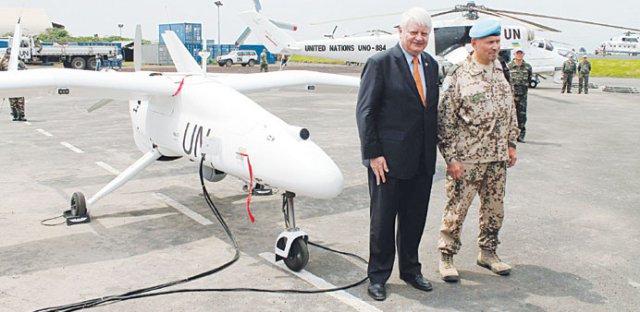UN forces in Democratic Republic of Congo launched unmanned aircraft on Monday to monitor the volatile border with Rwanda and Uganda, the first time UN peacekeepers have deployed unmanned surveillance aircraft.
The aircraft will be used to look out for threats from a host of local and foreign armed groups in the mineral rich east where Congo and UN experts have accused Rwanda and Uganda of sending arms and troops to back the recently-defeated M23 rebels, something both countries deny.
“The UAS … will allow us to have reliable information about the movement of populations in the areas where there are armed groups,” UN Under-Secretary-General for Peacekeeping Operations Herve Ladsous said at the launch of the UAS in Goma, the largest city in eastern Congo. “We will survey the areas where there are armed groups, and we can control the frontier,” he added.
The UN mission has deployed two Falco UAS manufactured by Selex ES, a unit of Italian defence group Finmeccanica . One of the 5m long aircraft – painted white with the letters UN in black on its wings and tail – performed a demonstration flight for the crowd at the launch.
The aircraft will be flown out of Goma by Selex staff. They can fly for between eight and 14 hours and as far as 200km from their base, according to the company.
UN peacekeepers have received widespread criticism for doing too little to end fighting in eastern Congo, a hilly and thickly forested region that Kinshasa has struggled to control during two decades of virtually constant conflict. But the UAS deployment comes after the peacekeepers helped defeat M23, the most serious rebellion of President Joseph Kabila’s 12-year rule.
General Carlos Alberto dos Santos Cruz, commander of the UN force in Congo, said the UAS would only fly over Congolese territory, as UN peacekeepers have no mandate to operate in neighbouring countries.
Victory over M23 was the first time Kinshasa had militarily defeated a major uprising in the east. It was helped by strong UN support, major reforms in Congo’s army and intense diplomatic pressure on Congo’s neighbours to halt rebel support. Congo and UN experts say foreign backing for M23 was significant. Following the defeat, experts are examining the origin of a significant stash of weaponry and trucks found at M23’s bases in hills along the Rwandan border.
The UAS were due to be launched as early as September, in the hope of monitoring the conflict taking place on the border. However delays meant they arrived only after M23 was defeated.
While a final political deal with M23 is still being ironed out, Congolese and UN forces are now expected to turn their attention to the Rwandan Hutu FDLR rebel group and Ugandan ADF-NALU rebels, both of which are based in Congo’s east. The UN yesterday announced its peacekeeping troops will go after other armed groups in the Democratic Republic of Congo, after helping to defeat the M23 rebel force. Tackling such groups is now “a prospect” for the UN’s 20,000-strong MONUSCO force and “that’s just what we are going to do,” the head of UN peacekeeping operations, Herve Ladsous
The UAS will survey mineral-rich territory fought over by dozens of armed movements, which the 3,000-strong special brigade, with soldiers from Malawi, South Africa and Tanzania, has been ordered to neutralise.
MONUSCO forms one of the two biggest UN missions in the world, along with the force in Darfur, Sudan. First deployed to the DR Congo in 1999 – and then known as MONUC—the mission has hitherto failed to prevent conflict.
Congo’s president wants talks with rebels in the country’s east concluded as soon as possible, Ugandan and Congolese statements said, although there was no sign of a breakthrough on the wording of an accord that scuppered a signing last month.
Kinshasa and Congo’s M23 rebels failed to seal the deal after squabbles over what it should be called – the insurgents were ready to sign a peace agreement but Congo wanted to call it a declaration that reflected the rebels’ military defeat. M23 are the latest incarnation of Tutsi-led insurgents who have battled Congo’s government in eastern regions for more than two decades.
Source: Gulf Times

